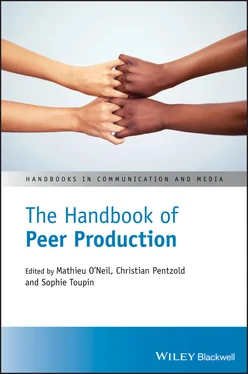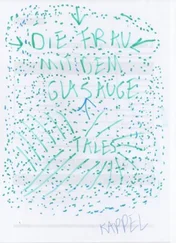So, tasks, products and services are organized as modules, which fit with other modules in a puzzle that is continuously re‐assembled. And granularity is a property of creating the smallest possible modules with the aim of lowering the threshold of participation (Benkler, 2006). Further, it should be easy to put the various contributions (the modules) into the final product. Also, effective quality‐control mechanisms should be in place to avoid low quality of contributions.
That being said, peer production projects do have systems of quality control. These “maintainers” (in free and open source software) or “editors” (in Wikipedia) protect the integrity of the system as a whole and can refuse contributions that endanger the integrity of the system. However, they do not coerce work. Peer production is based on freely engaged and passionate labor. Moreover, it eliminates some costs to capital. Hence, as we discuss next, it can also be embraced by for‐profit‐maximization forces, which explains the massive growth of peer production as a means to produce software for industry.
Peer production is neither hierarchy‐less, nor structure‐less (Freeman, 1970; Bauwens in Kostakis, 2010), but usually characterized by flexible and dynamic hierarchies and structures based on merit that are used to enable participation. Heterarchies combine elements of networks and hierarchies. Carole Crumley has offered one of the most common definitions (1979, p. 144), which suggests that heterarchy is “the relation of elements to one another when they are unranked, or when they possess the potential for being ranked in a number of different ways, depending on systemic requirements.” Thus, multiple levels exist where the communication among them is crucial in transcending the dysfunctions of traditional, rigid hierarchies.
Peer production introduces a cooperative framework that “includes both ranked and nested structures along with those that are flatter and networked” (Crumley, 2015, p. 9). In peer production, the emergence of dynamic hierarchies empowers a measure of cooperation and autonomy. The sole role of hierarchy is, therefore, the initiation and continuous flowering of autonomous cooperation.
Leadership is also “distributed.” Peer production projects are often led by a core of founders, who embody the original aims of the project, and who coordinate the vast number of individuals and micro‐teams working on specific patches. Their authority and leadership derive from their input into the constitution of the project (meritocracy), and on their continued engagement. Peer production projects may sometimes involve “benevolent dictatorships” (Kostakis, 2010); however, one must not forget that since the cooperation is entirely voluntary, the continued existence of such projects is based on the consent of the community of producers. One is always free to “fork,” i.e., to copy and modify and thus take the project to a different, independent direction; though in reality it could be quite difficult to attract a sufficient number of volunteers to a brand‐new project.
One of the essential features of P2P technologies is the liberation from the limitations of time and space. An ever‐larger number of people are not bound to their local circumstances, which includes territory in the virtual sense (e.g., organization or enterprise). This is now possible both for digital and material production. Workers can develop contributory lifestyles, and add and withdraw from paid and unpaid projects throughout their lives.
So, if cosmopolitanism is an ideological reflection of the capitalist mode of production and consumption (Marx & Engels, 1848), cosmolocalism (“cosmopolitanism” + “localism”) is an ideological reflection of peer production (Ramos, 2016; Bauwens et al., 2019). Cosmolocalism however comes partly from the understanding of cosmopolitanism from the Enlightenment. In short, cosmopolitanism asserts that all human beings belong to a single community, based on a shared morality and a shared future (Corradetti, 2017; Taylor, 2010). Cosmolocalism reflects the convergence of the global digital commons of knowledge, software, and design with local manufacturing technologies. Such technologies can be found in community‐driven places such as makerspaces or fablabs. Put simply, what is light (knowledge) becomes global commons, and what is heavy (machinery) is local and shared. Manufacturing, thus, takes place locally for local communities and specialized purposes. For example, see the production of a wide range of artifacts: from agricultural machines for small‐scale farming (Giotitsas, 2019), to low‐cost and customized prosthetic arms and off‐grid wind and hydro‐electric power generators (Kostakis et al., 2018). The shared morality comes through the commons, that is to say, through co‐creating and co‐managing both globally and locally shared resources (digital and physical).
To recap, peer production is based on open inputs; on a participatory process of coordinating the work; and on shared resources as output. This is in sharp contrast with the capitalist mode of production which is based on labor as a commodity in the input phase, hierarchical command following price signals in the production phase, and products and services for sale in the output phase.
We have presented above some of the constitutive components and operational rules of peer production projects, though we do not claim this list is exhaustive. Below, we discuss some of these components and rules in the context of a triarchy of entities within older and more recent ecosystems of peer production.
4 Entities of a New Commons‐Based Ecosystem
Through peer production we observe the emergence of a novel ecosystem of value creation consisting of three entities: productive communities; commons‐oriented entrepreneurial coalitions; and for‐benefit associations. Our description cannot be all‐inclusive because each ecosystem is unique. Moreover, it cannot be definite since we deal with a rapidly evolving mode of production. The aim is to offer a birds‐eye‐view of the expanding universe of peer production. The following table includes just five of the oldest and better‐known peer production ecosystems in the field of intangible production ( Figure 2.1).
In addition to the well‐documented ecosystems of free and open source software projects as well as Wikipedia, the cases of Enspiral, Sensorica, Wikihouse, and Farm Hack offer new perspectives on the rich tapestry of the increasing number of peer production ecosystems. They all fit within the parameters of our description that build new commons‐based ecosystems of value creation ( Figure 2.2). These examples also show the shift from purely digital production of software and knowledge, to the emergence of entities producing physical products and sophisticated services. Enspiral creates software; Sensorica is a project to make open source based scientific sources; Wikihouse produces designs to create sustainable housing; the Farm Hack community designs and manufactures open source machinery for small‐scale farming. What we see here is a replay of the tripartite institutional structure that we see in digital production. A recent study of the urban commons in Ghent (Bauwens & Onzia, 2017) shows that commons‐based urban provisioning systems also exemplify this new structure.

Figure 2.1 Five of the longest‐running and better‐known commons‐based peer production ecosystems.
Source: Bauwens, M., Kostakis, V. & Pazaitis, A. (2019). Peer to Peer: The Commons Manifesto. London: Westminster University Press, p. 16. © 2019 University of Westminster Press.
Читать дальше



![О Генри - Справочник Гименея [The Handbook of Hymen]](/books/407356/o-genri-spravochnik-gimeneya-the-handbook-of-hymen-thumb.webp)









